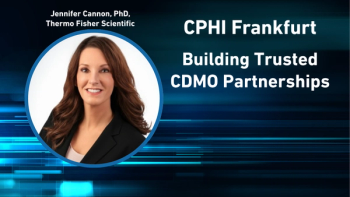
Outsourcing Perspectives from PPD
Experts from PPD provided commentary on the evolving role of contract services in analytical services.
Participants:
Brian Brandley, Ph.D., Director, Analytical Development, cGMP Labs
Magdalena Mejillano, Ph.D., Vice President, cGMP Labs
Technical/Scientific Trends
Analytical services
PharmTech: What emerging technologies or practices do drug sponsors expect your organization to provide?
Brian Brandley, Ph.D.: Mass spectroscopy capabilities are increasingly expected to be a more commonly available asset in contract analytical labs for supporting routine stability or development/validation studies, and not just for characterization studies. Quantitative mass spectrometry in particular is required for these services. Development/optimization of analytical methods, particularly when performed for bioassays, is expected to include experimental design to test/define method limits, reduce variability and support a conclusion of method robustness.
PharmTech: What scientific or technical advances have positively or negatively impacted drug development processes in this market segment?
Brian Brandley, Ph.D.: Growing application and acceptance for using reporter gene assays that improve the generation of signals relevant to a product’s mechanism of action has expedited the ability to develop and validate potency assays for biological products. This results in improving the sensitivity in assessing product comparability, whether across lots or in determination of stability, as well as in demonstrating the degree of sameness between an innovator and a proposed biosimilar.
PharmTech: Are you seeing shifts in demand for particular types of services? Please describe.
Brian Brandley, Ph.D.: One trend is a continued demand for extractable/leachable studies for broad array of dosage forms and products as a requirement for drug development and commercialization. In addition, E/L studies now are being extended to manufacturing process equipment and intermediate storage containers. Service requests performed by our biopharmaceutical services department are growing rapidly, particularly in support for follow-on biological and biosimilar products. Included in this is an increasing emphasis on a product’s functional characterization.
PharmTech: What pressing technical challenges have you seen in this market segment? What actions has your company taken to resolve the challenge? What actions does your company suggest?
Brian Brandley, Ph.D.: One technical challenge is the increasing expectation for the contract lab to evaluate impurities at trace levels as instrumentation capabilities become enhanced. However, this is often thwarted by obstacles caused by product matrix complications. Another area is the growing interest in the effects of aggregates on product performance, particularly regarding the impact on a product’s potency. Both the generation and evaluation of aggregates and their effects on product performance promise to increase the technical demands on the biopharmaceutical services team.
PharmTech: What actions has your company taken to resolve the challenge?
Brian Brandley, Ph.D.: Evaluating various sample prep clean-up options and automation are two of the approaches we are taking to address this. We are recommending that our clients initiate earlier and more extensive characterization of degradation conditions, and investigate the changes to a product’s physicochemical characteristics, as well as performance changes that might occur.
PharmTech: What advances do you see in science or technology in this market segment in the next five years?
Brian Brandley, Ph.D.: In the next few years, it is foreseeable that we will see more seamless integration of mass spectrometry with biological samples in aqueous buffers. In addition, routine, bench top NMR for impurities identification and characterization will be more commonly used. Plug and play mass detectors will be more routinely applied to LC and GC covering wide mass ranges.
Industry Trends
PharmTech: What business trends have positively or negatively impacted drug development/manufacturing processes in this market segment?
Magdalena Mejillano, Ph.D.: Clients are increasingly expecting ready access to data and technical documents through a centralized repository or portal that is interactive, flexible and easy to navigate. Clients often request key performance indicators including quality metrics, project turnaround times vs. targets, actual vs. budgeted spend, project team utilization, etc. Both trends have positively impacted drug development as a portal enhances efficiency and communication between the provider and the client, while KPIs allow tracking and trending performance to improve project execution.
PharmTech: What changes are you observing in the organization and operations of drug sponsors in this market segment?
Magdalena Mejillano, Ph.D.: There is a definitive shift in outsourcing analytical services for biologics and biosimilars compared to small molecules. In addition, extractables/leachables for both small and large molecule products as well as generic product testing are on a growth trajectory in terms of outsourced work. There also is increased engagement and influence from procurement groups within client organizations, which makes pricing and costs a more critical factor in the selection of service providers.
PharmTech: Describe the role that quality agreements play in contract services relationships. How will FDA’s draft guidance on quality agreements affect the relationships between contract service providers and drug sponsors?
Magdalena Mejillano, Ph.D.: Quality agreements continue to play a more significant role in shaping and managing contract services relationships. As greater scrutiny is applied by FDA on sponsors for oversight of their service providers, the more resources need to be allocated by both parties to meet the agency’s requirements. This creates more stress in organizations that already are experiencing capacity constraints. The added value and benefits that will be derived from these changes remains to be seen.
Newsletter
Get the essential updates shaping the future of pharma manufacturing and compliance—subscribe today to Pharmaceutical Technology and never miss a breakthrough.




